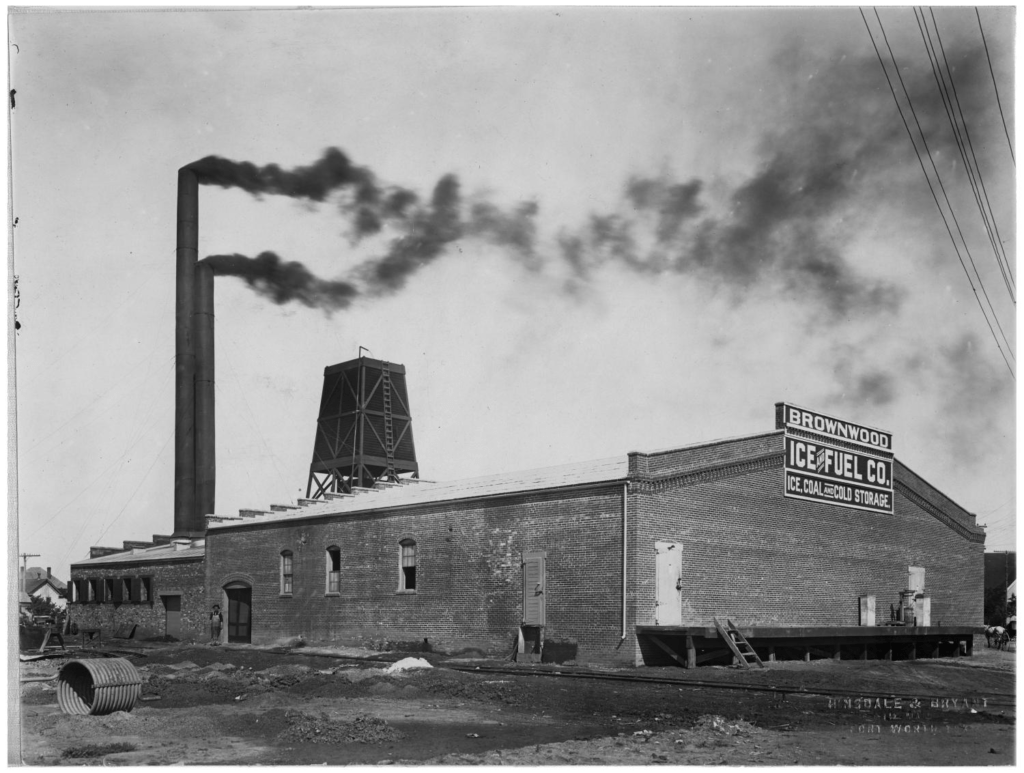
Just a few blocks from here, work continues on the new Brownwood Event Center which will include the Ice House event stage and pavilion. Perfect for outdoor concerts and other events.
There used to be an Ice House there, from which the new event stage area got its name.
This gets really interesting, so stick with me. It’s one of those deals that I do where I seem to go off on a tangent and then, cleverly, at the very end, it all comes back around.
I don’t know much about the ice house that was there over on Lee Street, but I’ve studied a lot about ice and ice houses in the past. When we first began living off-grid, I did hundreds of hours of research into how things were done before electricity. At first, we used regular Igloo-style coolers to ice down things like meat and drinks. We bought ice from the store in bags. As time progressed, we learned more about food preservation and didn’t “refrigerate” things as much, but we still liked to use ice to cool a few things – mostly as a luxury. I made a video about this topic when we were living off-grid. This video is from about 2019 or so. Anyway, at one point I determined that it was technically feasible for us to build a functional, non-powered icehouse wherein we could store ice that would be available for most of the year, even into the summers.
Technically feasible.
We (theoretically) could “harvest” ice during the winter, pack and store it in a well-designed icehouse, and then pull blocks as needed for our ice box. There would be some ice melt, of course, so next to the icehouse we would build a mostly underground spring house. The ice melt would flow by gravity through a channel into the spring house and we would store things there like butter, cheeses, and even canned drinks in the water of the spring house – which would serve as our “refrigerator.” This was the theory, and I went so far as actually drawing it out and designing it. We never built it, although I think it would work. One of the difficulties was in the actual ice harvesting. We don’t have very many days during our winters when the temperatures get cold enough to make a lot of ice. We certainly couldn’t harvest ice from our tanks because they rarely froze over, and when they did the ice was very thin. So, we would have to manufacture or purchase ice “forms”. A 6×9 aluminum pan would work. Then we’d have to fill the pans with water the night before a hard freeze. The trouble is it would take thousands of pans to make enough ice to fill an icehouse. And you can’t fill an icehouse little by little. The ice will melt too fast. It has to be filled quickly and all at once so that it will stay cold enough to keep the ice frozen. The blocks would have to be rapidly stacked, and then rows of blocks would be insulated by a LOT of sawdust or other safe insulating material.
I also considered using pipes. You know the feeling when your exposed pipes freeze in a winter storm. Even thick pipes, up to four inches thick, can freeze when it gets down below ten degrees. So, you could slice a pipe in half lengthwise (any length) Then hinge it together so it could be opened after it freezes and the ice could be extracted. These are just ideas, people. Don’t overthink it.
Anyway, in theory, it would work if you can make enough ice overnight, but we never built one.
A good friend of mine who lives up north actually found an old, antique “freezer” based on a patent by Albert Einstein that would freeze items in an insulated chest without the use of electricity. The general idea is that a gas or liquid (usually ammonia) in a vacuum in two connected chambers would be heated and as it evaporated and evacuated one chamber, it would flow into a second chamber in the insulated chest and become so very cold that it would freeze items in the chest. Even today, many refrigerators in older RVs use this same theory. A small flame (usually provided by propane) heats a coil in which Ammonia flows, as it evaporates and moves through the coils, the heat is expelled, and the cold coils refrigerate the contents of the refrigerator.
Before I studied this, I never knew that cold could be produced by creating heat!
In the picture I’ve attached here you can see the old Brownwood Ice and Fuel Company. I’m not sure if this is the same icehouse that was torn down on Lee Street, but you can see in the picture that there are smokestacks on the roof, and a “cooling tower” as well. A cooling tower is used to expel heat and to create cooling.
In the early 1800s, some entrepreneurial Yankees began industrially harvesting ice from huge lakes in the American Northeast. They cut blocks weighing from hundreds of pounds to many tons, packed the blocks in insulated trucks or ships, and shipped the ice all around the world. By the middle to late 1800s, ice was shipped around and into the Gulf of Mexico and all the way to Texas. Insulated, horse-drawn trucks were loaded with ice which was then hauled and delivered to ice houses all over the state. Local ice delivery men would deliver 10 lb. blocks of ice, or bags of ice “chips” to homes.
Some of you may remember the ice delivery men bringing in the block of ice and putting it down in the ice chamber of the “ice box.” (This is why many of us still call a refrigerator an “ice box.”) Every house had an ice pick so you could break off some ice chips to put into your drink! Homeowners would put a card in the window that would let the ice man know how many pounds of ice (and in what form) were needed.
One day, though, a salesman came by the house and the conversation went something like this:
Salesman: I can sell you an ice box that you plug into the wall, and it will keep your ice frozen! And this bottom section will be the “refrigerator.” You can store things like butter and cheese in there and it won’t melt!
Homeowner: I can’t afford one right now.
Salesman: We have easy credit payments, and for what you are already paying for ice, we can get you a new refrigerator! (They didn’t tell you that you would also be paying an elevated electric bill. Forever.)
Homeowner: I don’t like credit.
Salesman: Well… Ok. For cheapskates like you, we have this device here. We drill a hole in the top of your icebox, and this condenser device converts your non-electric ice box into a refrigerator.
Homeowner: I’ll take one, but… what will happen to my neighbor who works at the icehouse?
Salesman: Oh, don’t worry about him. The icehouses will still do fine. They’ll still sell ice here and there!
Well, that’s not really what happened. Many icehouses went out of business. Most of them Others began offering storage services (meat lockers) and others turned into convenience stores (this is how 7-11 got started.) Others became bars and live music venues, which is why a lot of bars in Texas are called icehouses.
Which brings us around full circle. Isn’t it fun to know that the new music venue a few blocks from here, in the footprint of the old Ice House, is called the Ice House Stage and Pavilion?
Do you think many of the concert-goers will know the whole history?
***
Michael Bunker is a local columnist for BrownwoodNews.com whose columns appear on Wednesdays and Sundays on the website.
